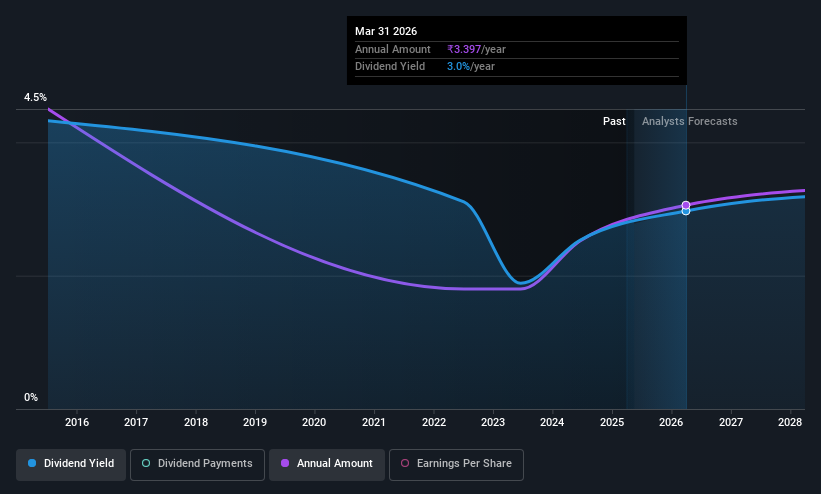Bank of India's (NSE:BANKINDIA) Dividend Will Be Increased To ₹4.05

Bank of India Limited (NSE:BANKINDIA) has announced that it will be increasing its dividend from last year's comparable payment on the 27th of July to ₹4.05. This will take the dividend yield to an attractive 3.5%, providing a nice boost to shareholder returns.
Bank of India's Earnings Will Easily Cover The Distributions
We like to see robust dividend yields, but that doesn't matter if the payment isn't sustainable.
Bank of India has a long history of paying out dividends, with its current track record at a minimum of 10 years. Using data from its latest earnings report, Bank of India's payout ratio sits at 19%, an extremely comfortable number that shows that it can pay its dividend.
EPS is set to fall by 13.3% over the next 3 years. Despite that, analysts estimate the future payout ratio could be 20% over the same time period, which is in a pretty comfortable range.

See our latest analysis for Bank of India
Dividend Volatility
Although the company has a long dividend history, it has been cut at least once in the last 10 years. Since 2015, the annual payment back then was ₹5.00, compared to the most recent full-year payment of ₹4.05. Doing the maths, this is a decline of about 2.1% per year. Generally, we don't like to see a dividend that has been declining over time as this can degrade shareholders' returns and indicate that the company may be running into problems.
The Dividend Looks Likely To Grow
With a relatively unstable dividend, it's even more important to evaluate if earnings per share is growing, which could point to a growing dividend in the future. Bank of India has impressed us by growing EPS at 49% per year over the past five years. Earnings have been growing rapidly, and with a low payout ratio we think that the company could turn out to be a great dividend stock.
Bank of India Looks Like A Great Dividend Stock
In summary, it is always positive to see the dividend being increased, and we are particularly pleased with its overall sustainability. The company is generating plenty of cash, and the earnings also quite easily cover the distributions. However, it is worth noting that the earnings are expected to fall over the next year, which may not change the long term outlook, but could affect the dividend payment in the next 12 months. All in all, this checks a lot of the boxes we look for when choosing an income stock.
Market movements attest to how highly valued a consistent dividend policy is compared to one which is more unpredictable. At the same time, there are other factors our readers should be conscious of before pouring capital into a stock. To that end, Bank of India has 2 warning signs (and 1 which can't be ignored) we think you should know about. Looking for more high-yielding dividend ideas? Try our collection of strong dividend payers.
Valuation is complex, but we're here to simplify it.
Discover if Bank of India might be undervalued or overvalued with our detailed analysis, featuring fair value estimates, potential risks, dividends, insider trades, and its financial condition.
Access Free AnalysisHave feedback on this article? Concerned about the content? Get in touch with us directly. Alternatively, email editorial-team (at) simplywallst.com.
This article by Simply Wall St is general in nature. We provide commentary based on historical data and analyst forecasts only using an unbiased methodology and our articles are not intended to be financial advice. It does not constitute a recommendation to buy or sell any stock, and does not take account of your objectives, or your financial situation. We aim to bring you long-term focused analysis driven by fundamental data. Note that our analysis may not factor in the latest price-sensitive company announcements or qualitative material. Simply Wall St has no position in any stocks mentioned.
About NSEI:BANKINDIA
Bank of India
Provides various banking products and services in India and internationally.
Proven track record with adequate balance sheet and pays a dividend.
Market Insights
Community Narratives




